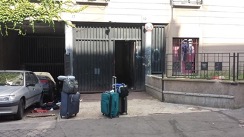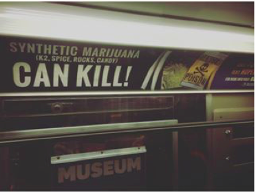When I hear:
You caught an attitude, you need food to eat up
I’m scheming like I’m dreaming on a couch with my feet up
You scream I’m lazy, you must be crazy
Thought I was a donut, you tried to glaze me
I just drown in hip-hop and junior high. I can plot a world from Paid in Full, not the whole Eric B & Rakim album, but enough to be back in the Bronx at I.S.158, spelling bees, science fairs, double-dutch, reading Donald Goines, hiding Donald Goines, reading Shakespeare, flaunting Shakespeare, noticing Patrick Morales’s “those eyes”, wearing a back brace, wearing a training bra, wearing knock-off Pony sneakers, riding the subway from the Bronx to Manhattan with a pocketful of payphone quarters to call my parents when I got to Prep for Prep’s brownstone to prep for prep school during that long eve of my future. And what that future looks like is at odds with the South Bronx where, in the 1980s, high schools were being fitted with daycare centers and metal detectors. Nope. I was too precious for that tomfoolery. “Jewel in the crown” is what Dr. Dunn, my principal, called me—what a metaphor, what a movie. But what a beat, Paid in Full brings you back to yourself and your space; your space in a beat, between beats, is a better metaphor where you have your feet up while people confuse your dreaming for laziness, or worse, confusing it as danger. Theirs.
Metaphor (carrying over)
A direct comparison between two unlike things: When I showed up at Andover in 1988, this dude wanted to know what gang I identified with back in New York. Of course, then, I thought he was kidding because we all took the same aptitude tests to get in. When I heard he asked other black frosh that question, I realize(d) the jewel in the crown had been removed.
A few years ago, I watched a 3-minute trailer on MHD (Mohamed Sylla), a French rapper of Ghanaian and Senegalese ascent who calls his music Afro Trap. It fuses Atlanta trap with his African roots. It’s just a three-minute preview so when their exchange spends 01:52 minutes discussing place, place is important. For MHD, place means that he has shot seven music videos in his neighborhood. Zach Goldblaum is in time to discuss MHD’s recent song “Afro Trap, Part 7 (La Puissance),” or the power. For the generous hipster interviewer, Goldbaum, the place is a layering of hardship, heavy kick drums and mad French rhymes. Can’t blame Zach. If you call a thing a trap, it traps.
Trap music is defined by its ominous, bleak and gritty lyrical content which varies widely according to the artist. Typical lyrical themes portrayed include observations of hardship in the “trap”, street life, poverty, violence and harsh experiences in urban inner city surroundings. (Wikipedia/trap music)
But, I take serious issue with the word “ominous.” Ominous to whom? Now if there were multi-layered beats at 112 Ocean Avenue (Amityville Horror), or on 3600 Prospect Street, Georgetown, Washington DC (Exorcist) I can see ominous—and how was the lyrical content on 1600 Pennsylvania Avenue for those four years? MHD lives in the 19th arrondissement of Paris, a place where the Charlie Hebdo shooters were, according to le media, radicalized. Zach asks MHD about this. MHD scoffs when his interviewer brings it up saying he should ask the media why they fixate on that. Clearly, they both know why.
Zach asks about having access to opportunities outside the neighborhood, implicitly reifying the trap and/or the afro as they sit on stools in the middle of a cleaned up courtyard between a group of five-story brick buildings. MHD explains, through a translator, he went to school and he never had problem finding work since his resumé was always full. He is explicitly reifying the glazed donut he has not become. I love this answer because it forces Zach and Viceland viewers to go beyond worn-out perceptions of “urban” and “inner.” Sometimes, when I hear the words inner city, it seems to be hailing the despondent by a private language of languish. I offer no gilded gospel to a choir of young believers. Shit gets real in the hood. Back when crack came in tiny vials, I remember (do you remember? Do you remember the time when we were…). To remember you would have had to have been a child of the 70s, an early-80s baby, or born earlier still. To remember the assonance and end rhyme of “crack is whack” echoing in the all-school assemblies in New York’s five boroughs, counties, and islands meant being a witness to crack’s ability to rebrand whole black and brown geographies and communities. To remember means having looked down at the imperfections in the pavement when you are turning one end of the double-dutch rope to make sure there weren’t cracks big enough to catch the rope so as to affect its beat. To remember being such a responsible rope turner meant telescoping your eyes into breaks and dips of the pavement and seeing tiny red, green, or black lidded vials. Crack vials are a worthy Google search for the now generations. They looked like the tiny vials eyeglass repair screws are put in. Sometimes squirrels would get to what was left. I’ve seen it; not an urban legend but nature without nurture. What might Afro Trap say about that scene of furry hardship?
So what happens next?What I find refreshing in this Viceland preview interview is the promise of hipster and hip hop—neither mutually exclusive—finding out they are responsible for manipulating the other.
La puissance
Gros, c’est la puissance, c’est la puissance
[Bro, it’s the power, it’s the power]
When I visit France in 2016, the AirBnB address is unclear. A and S assure us (my sister Michelle and my girl Leah) their spot is hip. A and S caution us about accurate directions:
Hi,
The closest station from the apartment is Garibaldi on the 13th line (be careful to take the right direction to “Saint Denis”). Let us know when you’re close.
Cheers
A—-
Aug 31, 2016
In hindsight, it was funny but getting out of an Uber with luggage and duty free from London and Reykjavik, two places you’ve walked around more than ridden, to save money with two tired Pisces women and face:
 was not our idea of vacation or Paris or safe or quiet. What this was was a way better photo from a distance, a shooting distance, a camera’s lens. Inside this courtyard was a country. The chickens—as Malcolm X once said— came home to roost in all their post-colonial glory with car batteries, soiled strollers, old men on kitchen chairs and browning sofas, uncollected trash, uncollected trash, uncollected trash. We laughed. I remember our/my first thoughts were we got hoodwinked by AirBnB; after all, it was the summer of unveiling discriminatory practices with some of the company’s hosts. There was a class action lawsuit alleging then proving how AirBnB hosts would cancel reservations or deny reservations from people of color. Happened to Leah in Oxford. If there was discrimination afoot, then why not mendacity, affront. Why not go the opposite and just invite anyone to chicken roost? We laughed. It wasn’t funny, but we laughed. Then, I turn to see S at the end of the block standing like a—yes I thought it—knight in shining armor. A rescuer.
was not our idea of vacation or Paris or safe or quiet. What this was was a way better photo from a distance, a shooting distance, a camera’s lens. Inside this courtyard was a country. The chickens—as Malcolm X once said— came home to roost in all their post-colonial glory with car batteries, soiled strollers, old men on kitchen chairs and browning sofas, uncollected trash, uncollected trash, uncollected trash. We laughed. I remember our/my first thoughts were we got hoodwinked by AirBnB; after all, it was the summer of unveiling discriminatory practices with some of the company’s hosts. There was a class action lawsuit alleging then proving how AirBnB hosts would cancel reservations or deny reservations from people of color. Happened to Leah in Oxford. If there was discrimination afoot, then why not mendacity, affront. Why not go the opposite and just invite anyone to chicken roost? We laughed. It wasn’t funny, but we laughed. Then, I turn to see S at the end of the block standing like a—yes I thought it—knight in shining armor. A rescuer.
After we settled in and the laughter died we were utterly mind-fucked at how close these two apartment complexes were. It was the flea market district and it was either getting gentrified or had just maintained pockets of habitability through whatever neighborhood changes came over the years. The progress/regress was architecturally uneven. We don’t really know how neighbors got along because we didn’t stay long. We didn’t know who was old or who was new and who could be the scorekeeper of that? It reminded me of standing in Gross Pointe facing Detroit, standing in Chicago facing Cabrini Green looking at the people-generated space. A curation of space is a trap unfolding a violence of proximity.
It is difficult to avoid these observations. It is difficult not to come to rapid and conflicting conclusions about the whole mess of gentrification. If you close read the space cleared out for Zach Goldbaum’s interview of MHD, with the two stools in the middle of a courtyard and some P.A. off camera controlling set movement telling people when to walk by and when not to and the boom being high enough to be cropped out of frame then that is a kind of curation of space that makes absent the quotidian of the 19th. The camera displays the pretty. The camera comes out and everyone has on their Sunday best. Sista-friend in the background wears her cute floral jumper and Remy hair. Aunty is wearing matching dhuku and dress. The kids—bless their M&M chocolaty cuteness—are melting in our mouths. The interview is, after all, about the music that comes out of this space, produced by this space, connecting the American south and the African west across space. For this particular reason, it is necessarily curated to breach the trap, but not the afro.
When I see: home, New York, I am reminded of the stuff, material and mental, that I own here—here today is northern California. Stuff that I bought at Double Discount (see above), stuff you can only get for $3.99 when ethnicity is for realz and not an aisle in Whole Foods. This is stuff that points to other stuff I own in California and I am talking about both duplicated purchases and upgraded experiences. I miss my number 2 train and 5 train but a car is an upgrade. And I think about how clean my Toyota is tonight, back in California, while I ride the number 2 train from Franklin Ave. in Brooklyn back home to Freeman Street in the Bronx. I was visiting Darianne and her two-month old baby, Isabel Maya, but we only call her by her West Indian nickname Bubsy. The nickname comes at the same time as the birth certificate name. They are hybrid callings not a surprise branding or rebranding. (Although, I did try to make C-boogie work in the fifth grade).
I think about the smell of the subway air gushes in every time the doors open. Not bad tonight. Electricity and rat dander, a tinge of very old urine. There’s a sign across from me, above. K2 spice rocks candy sounds way better than just say no. Synthetic cannabinoids are designer drugs chemically different from pot itself. There was a woman on NPR talking about how one hit destroyed this teen’s brain. The interviewer, this time or another, asks about the new direction the country is taking with regards to drug education and prevention. We have shifted from war to a conversation on drugs. From Hakim’s problem to Bobby’s intervention. In my head, I free associate synthetic marijuana with gentrification because they emerge over the airwaves contemporaneously like kissing cousins. First cousins who should know better. One hit can destroy a life. One hipster can destroy a bodega.
We are no longer warring against drugs, but entering into a conversation. I remember how the war looked. From first through eighth grade, the public school district would bring in cops, ex-junkies, motivational speakers, and rap music to teach us little black and brown things how to say “no”. Crack is whack, after all. In the third grade, I remember once, a speaker who was this handsome Latino cop from the neighborhood at some point in his history, brought in a specimen box of drug paraphernalia so we could identify what to say no to. There was a lot to try. He gave us statistics about addiction. How little samples get you hooked. Were boogers gateway indulgences? Where would he plot us booger samplers on his histogram of user inevitability. He gave us statistics that made me doubt half my class even had parents, homes, refrigerators, or love. He, or maybe it was Mr. Ortiz, our principal, made us recite some anti-drug pledge. He was in uniform, a cop, a motivational cop with a box of crack and needles and pipes and pills and I remember feeling insulted by the intervention, by the assumption, made by the I-used-to-live-down-the block cute Boricua with gum in his mouth and a badge on his chest.
 I think of synthesis. I think of the amalgam of crack vials and shades of children on the eve of the eve of their futures. We ought to know better, but we don’t. We ought to trust his gummy mouth, but we won’t. I’ll be valedictorian in two years, then again in eighth grade. Who has time for condescending bullshit? What is afoot and what is affront? I was (am still) being synthesized. Was it photo-synthesis? Did he see our faces in his future suspect photo album? There was everything on TV and in print. Was it convergent synthesis? There was every kid in the school in the auditorium. Because Caribbean people who used social distance as a way to keep the chip glued to my shoulder raised me, it was antithesis. “What the ras?!” I’m pretty sure this is what my father said when I told him about it. He was even more affronted by the waste of time passing out display crack instead of Keats or long division. He didn’t walk barefoot for six miles to school in Guyana, emigrate to America, get robbed working as a cab driver, stand for hours in the rain as a doorman at Trump Plaza and get robbed managing a fast food joint all while going to Lehman College to have his kids learn about how not to use drugs because it was assumed we’d learned how to from our likely-absent parents. Back then, not a fan of Americans but a huge fan of the American Dream, my father, I’m sure, made my brother and I do extra homework to make up for or to clean away trace elements of Officer Intervention’s inner urban afro synthesis of our potentials, of what is within our power.
I think of synthesis. I think of the amalgam of crack vials and shades of children on the eve of the eve of their futures. We ought to know better, but we don’t. We ought to trust his gummy mouth, but we won’t. I’ll be valedictorian in two years, then again in eighth grade. Who has time for condescending bullshit? What is afoot and what is affront? I was (am still) being synthesized. Was it photo-synthesis? Did he see our faces in his future suspect photo album? There was everything on TV and in print. Was it convergent synthesis? There was every kid in the school in the auditorium. Because Caribbean people who used social distance as a way to keep the chip glued to my shoulder raised me, it was antithesis. “What the ras?!” I’m pretty sure this is what my father said when I told him about it. He was even more affronted by the waste of time passing out display crack instead of Keats or long division. He didn’t walk barefoot for six miles to school in Guyana, emigrate to America, get robbed working as a cab driver, stand for hours in the rain as a doorman at Trump Plaza and get robbed managing a fast food joint all while going to Lehman College to have his kids learn about how not to use drugs because it was assumed we’d learned how to from our likely-absent parents. Back then, not a fan of Americans but a huge fan of the American Dream, my father, I’m sure, made my brother and I do extra homework to make up for or to clean away trace elements of Officer Intervention’s inner urban afro synthesis of our potentials, of what is within our power.
There is a line in MHD’s song, “Afro Trap, Part. 7 (La puissance)” that goes, “Pour qu’j’arrête, faut qu’on m’tranche les cordes vocales.” It translates to: For me to stop, my vocal chords must be cut. I imagine the microanatomy of muscle and membrane cut and splayed out to stop the phonation of rap and therefore questions of subjecthood. The image makes me think of a character in an Afrofuturist short story by Darryl K White, “The Pretended,” about robots being sent to an incinerator when faults in their programming make them sense they are people and rather than just “black—not people.” A young black character named Demal has his head burst with “hopeless circuits and pieces” left all over the street when he is overcome by an overload of content from “underground music” rich from an “age of vernacular.” This music resonates across channels and time carrying a message listing the grievances of malplacement, or the ways in which The Man or the haters question your subjecthood in lyrics like “History!, Dis!story, Fist!ory/We got da missed story, da list gory/ See? I’m pissed, tired a dis shit/ We endin it, offendin it, sendin it.” It is a vernacular that extolls both emancipatory and extrajudicial solutions for artificial life. Life produced by humans, a copy of something that isn’t enough in this case.
From Atlanta to the 19th arrondissement, “Afro Trap, Part 11 (King Kong)” carries the sound of gunshots, “pah,pah…” that is choreographed in the music video with dancers on a spinning 45 RPM record falling down as if shot by MHD. It may be a good time for an interlude revealing that to date there are eleven parts to Afro Trap. Parts one through eight are, for the most part, filmed on the streets with homies. Part nine uses some special effects exaggerating MHD’s face and mouth. He rocks a Puma top when he was a spokesperson for the brand. Part 10 is full of homies but is shot in a warehouse. It comes out in 2018, the year he is charged with second-degree manslaughter. He claims his innocence but is remanded in custody in which time he contracts Covid and recovers. MHD is released under supervision and makes “Afro Trap, Part 11(King Kong).” As if to synthesize the experience of malplacement, this video is shot on a soundstage with scenes depicting MHD as a King Kong-sized man moving about the miniature artificial world, even napping in a mini bed. In 2016, the Vice producers curate a shot with MHD surrounded by Little Africa local color. In 2021, Afro Trap simulates urban inner city life as a stylized fable. The music video still features homies, but there is no longer a street life for Zach and Viceland viewers to study wondering how this is “the place where the Charlie Hedbo shooters were radicalized.” There is only afro synthesis.
The 19th arondissement (Belleville) along with the 11th (Oberkampf), and the 13th (Chinatown) are observed by travelers and bloggers as three Paris neighborhoods resisting gentrification. However, there are reports of brand named retail moving in. Change is inevitable. But, the stickiness of “gentrification” asks by whose hands does this new life get made, and for whom is it made. Three years ago, Darianne predicted, “Crown Heights is next on the chopping block. I’m a fucking doctor; I grew up here and I can’t afford to buy here. Wait until they get the Bronx.” So-Bro is want “they” want to call it. Yup, some bullshit. I agree that it’s already happening. “They” be getting on my nerve. On the west coast, I watch how “they” try to change South Central to South Los Angeles and Inglewoood to I-Wood. The word “village” comes after real estate conjunctions like PicFair and juice bars are introduced in Futura font as if folx haven’t been vegan clean living before white people showed up.
Those three years ago, I remember getting off at my stop in the Bronx after visiting Darianne in Brookyln. In the truth of the night, I remember not much had changed. And that three weeks ago, I remember The South Bronx still sounds like the screeching friction of metal train brakes on the elevated tracks; still smells like cuchifritos and pizza; still tastes like morcilla on my tongue; and still looks like the bullet-proof windows of Chinese food restaurants where the no#5 is slathered in MSG chicken broth posing as the vegetarian option but it still smells so good wafting through the breathe-holes in the 1 inch glass. Attempts at gentrifying her amounted to fresh coats of pastel paint on pill box buildings renamed from “projects” to “housing development.” Her landmark factories are chopped up into awesome high rent lofts overlooking a bridge that leads into the borough no one can afford. Pioneers of the creative class of thirty-somethings living in a renovated building with a view of Crotona Park have been sighted. It’s become so very “go west young man” when you see how many single white dudes are rolling with the homies. These surprise encounters makes me think about Ms. Pacman eating her way into pellet oblivion avoiding ghosts: Inky, Pinky, Blinky, and Clyde until her domain changes on her, unawares. She turns a corner and bam, a ghost. Sound and color change up makes me anxious. “Wait until they get the Bronx.” I think about Darianne’s warning. Maybe it could be an invitation meaning they will “get” the Bronx, as in get to know her. That doesn’t sound bad. But the anxiety is really about the first muthafucker who uses the phrase So-Bro in a sentence about the geographic boundaries of the Bronx. What do I do? Do I correct with or without bloodshed. Throat kill. Voice box damage? But it’s not like I live live here anymore. What can I do about it? Just say no? The ghosts will always turn their focus onto Ms. Pacman curious about what she’s been doing. What has she been doing? Why wasn’t she doing more? I have a hard time finishing this game. Gangbang scenario. Ominous content to a steady beat, indeed. Wait until they get her, I think. Abort. The violence of proximity. Game over? Nah. Extra lives before artificial life. Gros, c’est la puissance.


